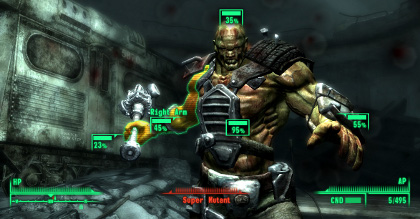But undoubtedly the most visionary new multiplayer game to emerge that year was PC and 360 title Left 4 Dead. Focusing on teamplay, Valve put four players in a series of classic B-movie scenario, with various, cunningly designed specimens of zombie ready to feast on their brains at a moment’s notice. Chief among the game’s beauties was the ‘AI director’, which altered the nature and distribution of threats in response to player performance. No two rounds of Left 4 Dead are alike.
By the middle of the current generation, it was clear that console versions were, for the most part, on an equal gameplay footing with their PC cousins – a situation 15 years in the making. PC versions could still boast the superior frame rate and graphical detail, but to most consumers this seemed a scant return on the hardware investment.
In terms of FPS storytelling, 2008 was evenly split between dreadful mediocrity and shining brilliance. By far the most high profile FPS disaster for some time was Free Radical’s dire PS3-exclusive, Haze, but it wasn’t alone. Spark managed the impressive feat of producing two horribly generic titles in the same year with Turning Point and Legendary – a feat Treyarch couldn’t quite match, despite a horribly bland Bond attempt, Quantum of Solace, and another less-than-stellar Call of Duty title, World At War.
Towards the other end of the scoring spectrum, most of the excitement came from solid, if less than revolutionary, sequels. Ubisoft managed to maintain its generally impressive track record with Far Cry 2 and Rainbow Six Vegas 2, while Insomniac was applauded for its Resistance sequel.
But the most ground-breaking turn came from an unlikely source – Bethesda. A specialist in massive first/third person Elder Scrolls fantasy RPGs, its revival of the long-dormant Fallout franchise was arguably the game of the year. A compelling mixture of first person shooting and RPG, Fallout 3 blended old and new gameplay elements into a unique and uniquely compelling whole.
Particularly interesting was its new ‘VATS’ system, which allowed players to freeze the action and target individual body parts using a limited stock of ‘action points’, before finishing the job with relatively inaccurate, real-time gunplay. Fallout 3 also demonstrated that post-release episodic content could be a significant success if properly coordinated, its five three-to-four hour chunks all arriving within six months of launch.







 Satoru Iwata Video Interview - the late Nintendo president spoke with Kikizo in 2004 as 'Nintendo Revolution' loomed.
Satoru Iwata Video Interview - the late Nintendo president spoke with Kikizo in 2004 as 'Nintendo Revolution' loomed. Kaz Hirai Video Interview - the first of Kikizo's interviews with the man who went on to become global head of Sony.
Kaz Hirai Video Interview - the first of Kikizo's interviews with the man who went on to become global head of Sony. Ed Fries Video Interview - one of Xbox's founders discusses an epic journey from Excel to Xbox.
Ed Fries Video Interview - one of Xbox's founders discusses an epic journey from Excel to Xbox. Yu Suzuki, the Kikizo Interview - we spend time with one of gaming's most revered creators.
Yu Suzuki, the Kikizo Interview - we spend time with one of gaming's most revered creators. Tetris - The Making of an Icon: Alexey Pajitnov and Henk Rogers reveal the fascinating story behind Tetris
Tetris - The Making of an Icon: Alexey Pajitnov and Henk Rogers reveal the fascinating story behind Tetris Rare founders, Chris and Tim Stamper - their only interview? Genuinely 'rare' sit down with founders of the legendary studio.
Rare founders, Chris and Tim Stamper - their only interview? Genuinely 'rare' sit down with founders of the legendary studio. The History of First-Person Shooters - a retrospective, from Maze War to Modern Warfare
The History of First-Person Shooters - a retrospective, from Maze War to Modern Warfare
[...] Parte 5 (2006-2009) Categorías: VideojuegosTags: crysis, FPS, Halo, juegos, Quake [...]